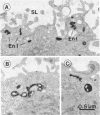Abstract
We have compared the behavior of 125I-labeled asialoorosomucoid (ASOR) and 125I-labeled asialotriantennary glycopeptide (TRI) from alpha-1-protease inhibitor in the perfused rat liver. These two ligands are recognized and internalized by the Gal/GalNAc receptor system of hepatocytes. We found that both ligands could be efficiently degraded when continuously perfused through a liver at 37 degrees C. However, as much as 51% of the internalized 125I-labeled TRI was rapidly (t1/2 = 3 min) released intact into the perfusion medium under conditions that permitted ligand-receptor association. In contrast, ASOR was totally degraded under these conditions. When dissociation was promoted (i.e., in the presence of GalNAc or EGTA), as much as 57% of the internalized ASOR was rapidly released (also intact). In each case, the shorter the initial internalization phase, the greater the proportion of ligand that was subsequently released. Neither the degree of receptor occupancy nor the temperature (16-37 degrees C) during the initial internalization phase influenced the rate or extent of the release process. Electron microscopic localization of internal ASOR-horseradish peroxidase conjugate demonstrated that peripheral endosomes were the major compartment labeled during exocytosis. We conclude that substantial fractions of both ligands rapidly return to the cell surface after internalization, ASOR bound to receptor and most of TRI free from receptor. The remaining ligand molecules enter the lysosomal pathway.
Full text
PDF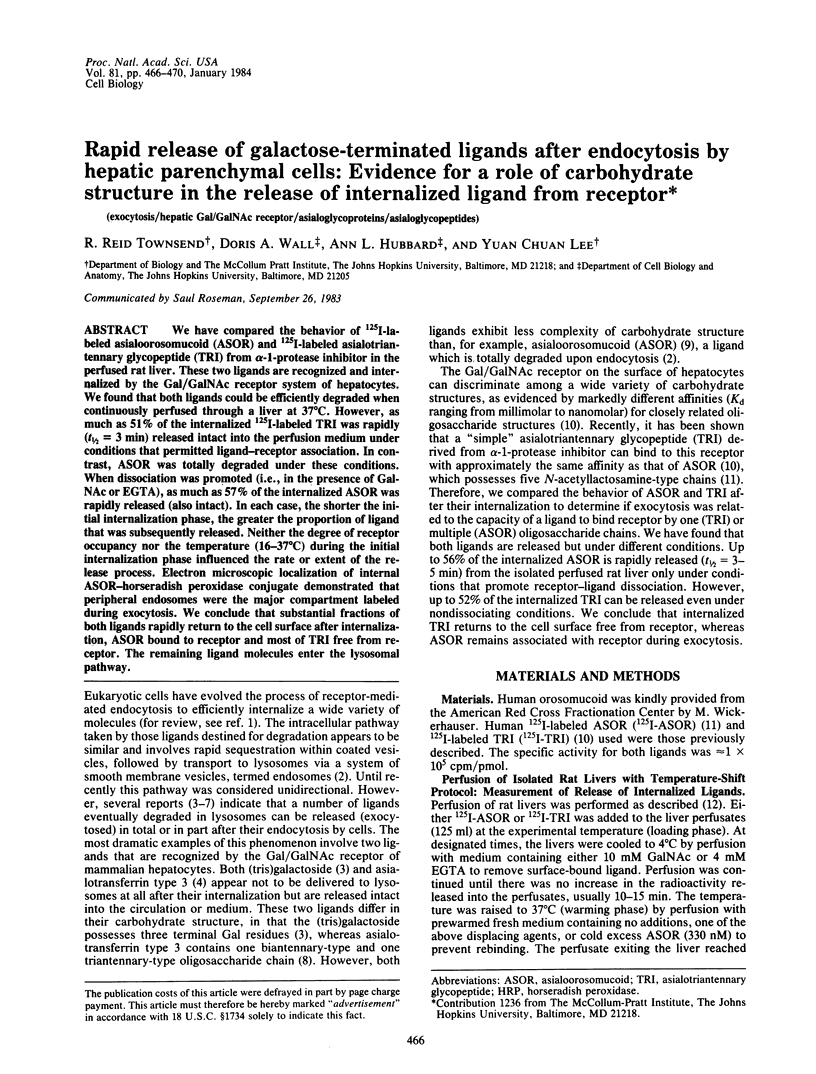
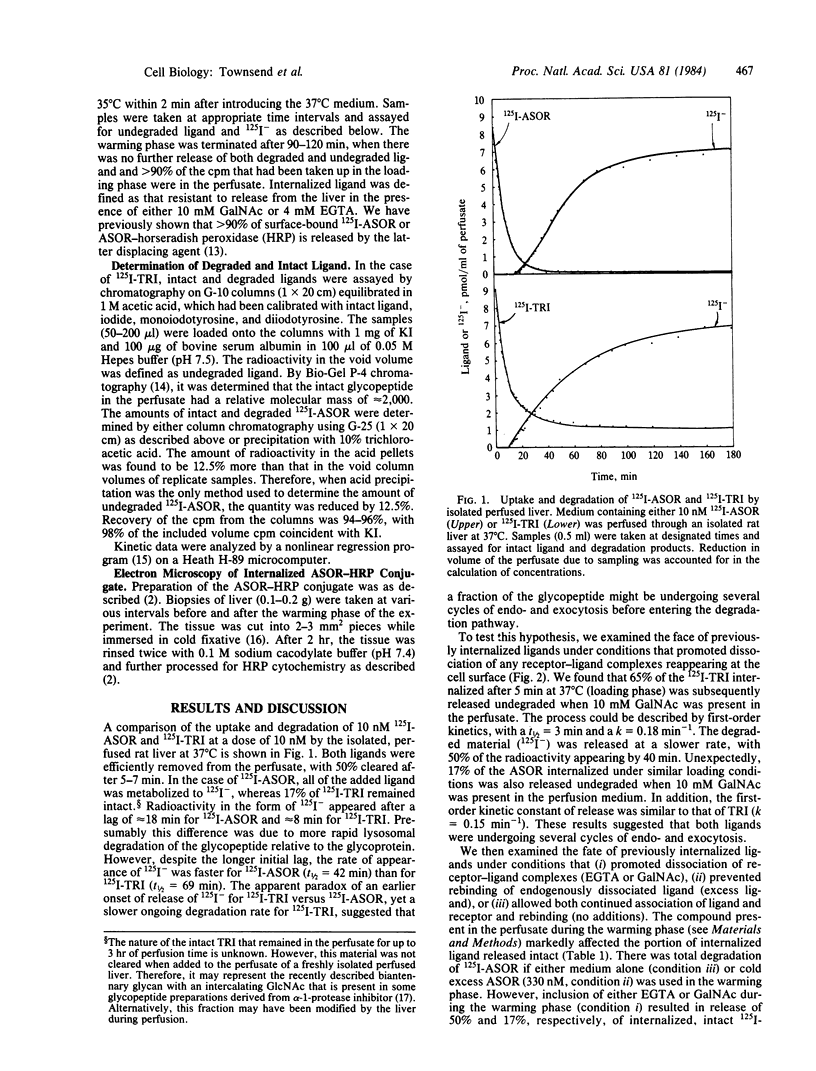
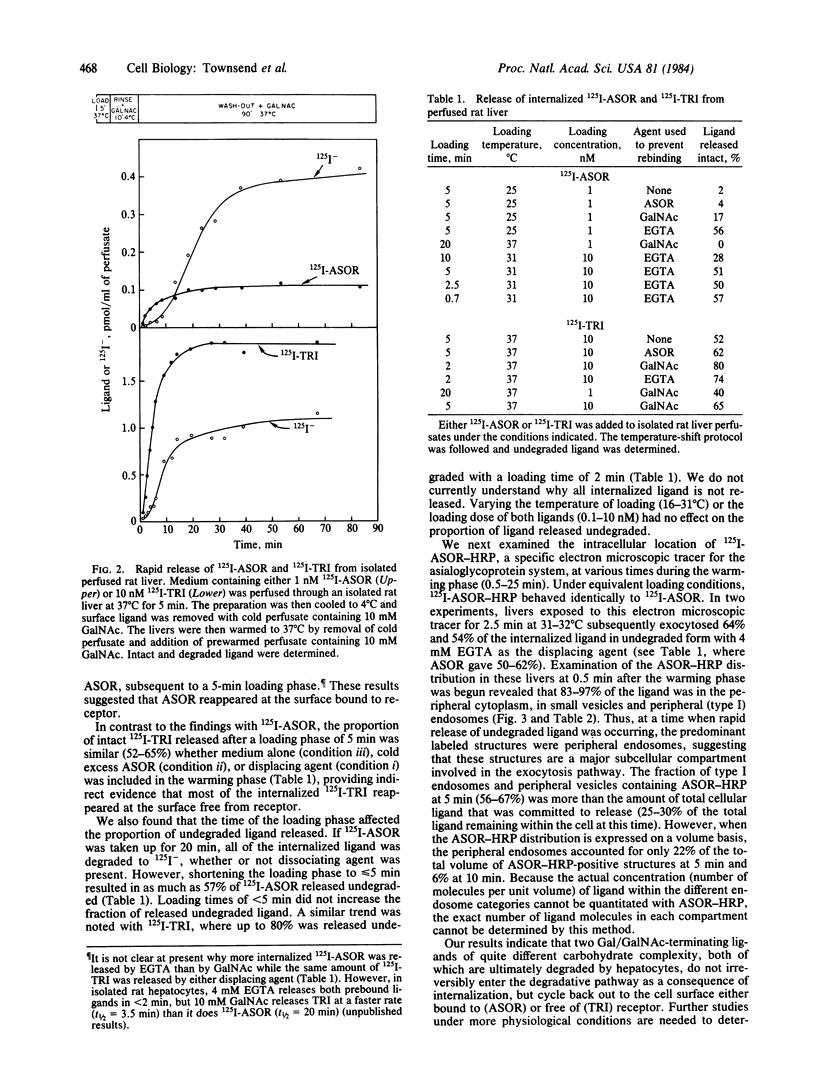
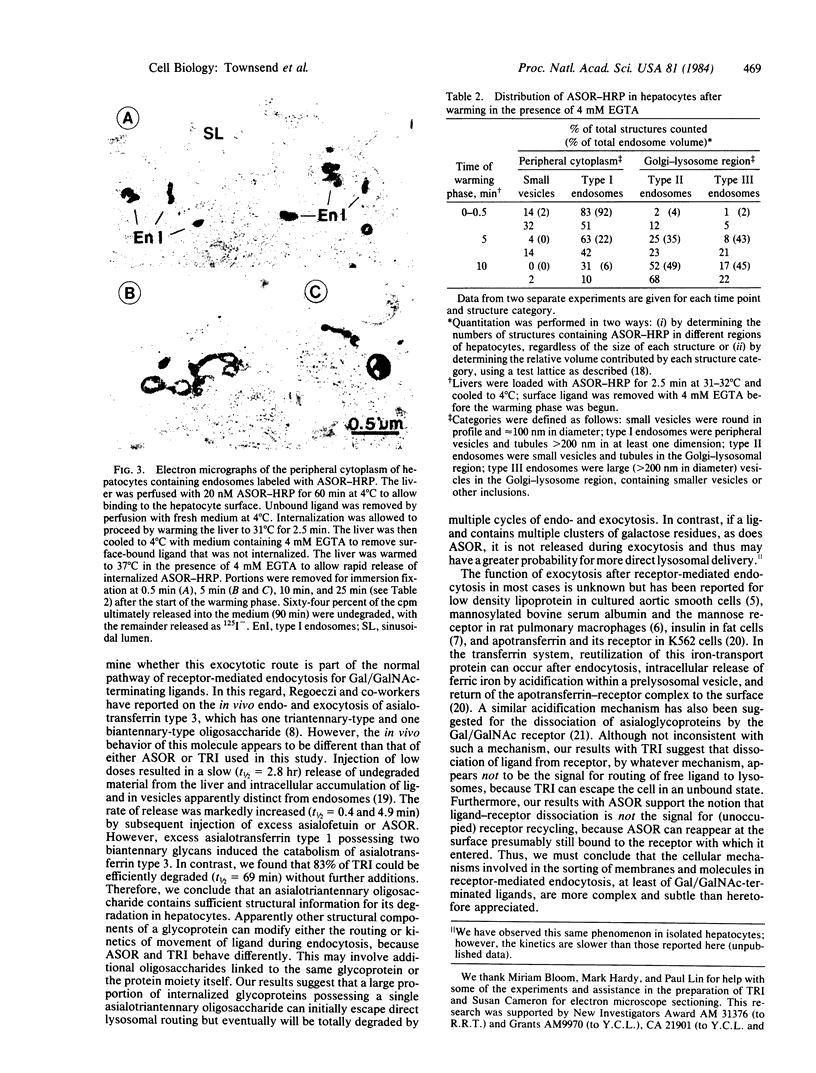
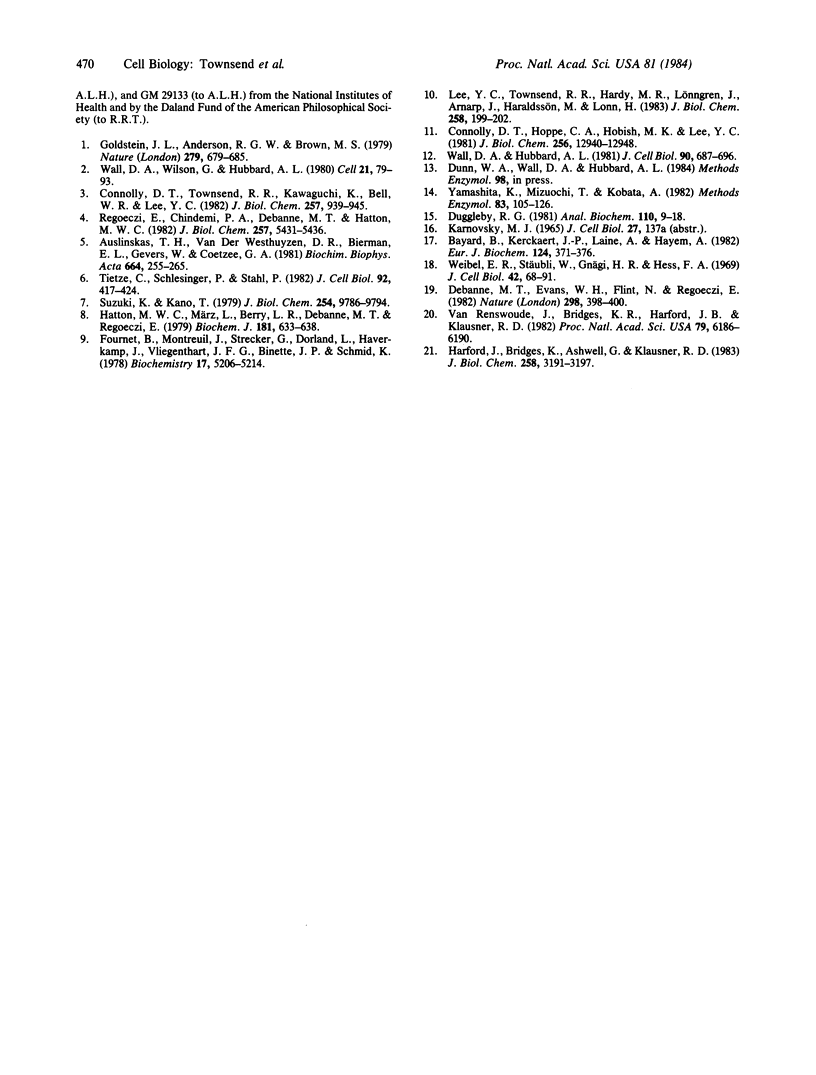
Images in this article
Selected References
These references are in PubMed. This may not be the complete list of references from this article.
- Aulinskas T. H., van der Westhuyzen D. R., Bierman E. L., Gevers W., Coetzee G. A. Retro-endocytosis of low density lipoprotein by cultured bovine aortic smooth muscle cells. Biochim Biophys Acta. 1981 May 22;664(2):255–265. doi: 10.1016/0005-2760(81)90048-5. [DOI] [PubMed] [Google Scholar]
- Bayard B., Kerckaert J. P., Laine A., Hayem A. Uniformity of glycans within molecular variants of alpha-protease inhibitor with distinct affinity for concanavalin A. Eur J Biochem. 1982 May 17;124(2):371–376. doi: 10.1111/j.1432-1033.1982.tb06602.x. [DOI] [PubMed] [Google Scholar]
- Connolly D. T., Hoppe C. A., Hobish M. K., Lee Y. C. Steady state and kinetic analysis of the binding of asialoorosomucoid to the isolated rabbit hepatic lectin. J Biol Chem. 1981 Dec 25;256(24):12940–12948. [PubMed] [Google Scholar]
- Connolly D. T., Townsend R. R., Kawaguchi K., Bell W. R., Lee Y. C. Binding and endocytosis of cluster glycosides by rabbit hepatocytes. Evidence for a short-circuit pathway that does not lead to degradation. J Biol Chem. 1982 Jan 25;257(2):939–945. [PubMed] [Google Scholar]
- Debanne M. T., Evans W. H., Flint N., Regoeczi E. Receptor-rich intracellular membrane vesicles transporting asialotransferrin and insulin in liver. Nature. 1982 Jul 22;298(5872):398–400. doi: 10.1038/298398a0. [DOI] [PubMed] [Google Scholar]
- Duggleby R. G. A nonlinear regression program for small computers. Anal Biochem. 1981 Jan 1;110(1):9–18. doi: 10.1016/0003-2697(81)90104-4. [DOI] [PubMed] [Google Scholar]
- Fournet B., Montreuil J., Strecker G., Dorland L., Haverkamp J., Vliegenthart F. G., Binette J. P., Schmid K. Determination of the primary structures of 16 asialo-carbohydrate units derived from human plasma alpha 1-acid glycoprotein by 360-MHZ 1H NMR spectroscopy and permethylation analysis. Biochemistry. 1978 Nov 28;17(24):5206–5214. doi: 10.1021/bi00617a021. [DOI] [PubMed] [Google Scholar]
- Goldstein J. L., Anderson R. G., Brown M. S. Coated pits, coated vesicles, and receptor-mediated endocytosis. Nature. 1979 Jun 21;279(5715):679–685. doi: 10.1038/279679a0. [DOI] [PubMed] [Google Scholar]
- Harford J., Bridges K., Ashwell G., Klausner R. D. Intracellular dissociation of receptor-bound asialoglycoproteins in cultured hepatocytes. A pH-mediated nonlysosomal event. J Biol Chem. 1983 Mar 10;258(5):3191–3197. [PubMed] [Google Scholar]
- Hatton M. W., März L., Berry L. R., Debanne M. T., Regoeczi E. Bi-and tri-antennary human transferrin glycopeptides and their affinities for the hepatic lectin specific for asialo-glycoproteins. Biochem J. 1979 Sep 1;181(3):633–638. doi: 10.1042/bj1810633. [DOI] [PMC free article] [PubMed] [Google Scholar]
- Lee Y. C., Townsend R. R., Hardy M. R., Lönngren J., Arnarp J., Haraldsson M., Lönn H. Binding of synthetic oligosaccharides to the hepatic Gal/GalNAc lectin. Dependence on fine structural features. J Biol Chem. 1983 Jan 10;258(1):199–202. [PubMed] [Google Scholar]
- Regoeczi E., Chindemi P. A., Debanne M. T., Hatton M. W. Dual nature of the hepatic lectin pathway for human asialotransferrin type 3 in the rat. J Biol Chem. 1982 May 25;257(10):5431–5436. [PubMed] [Google Scholar]
- Suzuki K., Kono T. Internalization and degradation of fat cell-bound insulin. Separation and partial characterization of subcellular vesicles associated with iodoinsulin. J Biol Chem. 1979 Oct 10;254(19):9786–9794. [PubMed] [Google Scholar]
- Tietze C., Schlesinger P., Stahl P. Mannose-specific endocytosis receptor of alveolar macrophages: demonstration of two functionally distinct intracellular pools of receptor and their roles in receptor recycling. J Cell Biol. 1982 Feb;92(2):417–424. doi: 10.1083/jcb.92.2.417. [DOI] [PMC free article] [PubMed] [Google Scholar]
- Wall D. A., Hubbard A. L. Galactose-specific recognition system of mammalian liver: receptor distribution on the hepatocyte cell surface. J Cell Biol. 1981 Sep;90(3):687–696. doi: 10.1083/jcb.90.3.687. [DOI] [PMC free article] [PubMed] [Google Scholar]
- Wall D. A., Wilson G., Hubbard A. L. The galactose-specific recognition system of mammalian liver: the route of ligand internalization in rat hepatocytes. Cell. 1980 Aug;21(1):79–93. doi: 10.1016/0092-8674(80)90116-6. [DOI] [PubMed] [Google Scholar]
- Weibel E. R., Stäubli W., Gnägi H. R., Hess F. A. Correlated morphometric and biochemical studies on the liver cell. I. Morphometric model, stereologic methods, and normal morphometric data for rat liver. J Cell Biol. 1969 Jul;42(1):68–91. doi: 10.1083/jcb.42.1.68. [DOI] [PMC free article] [PubMed] [Google Scholar]
- Yamashita K., Mizuochi T., Kobata A. Analysis of oligosaccharides by gel filtration. Methods Enzymol. 1982;83:105–126. doi: 10.1016/0076-6879(82)83008-5. [DOI] [PubMed] [Google Scholar]
- van Renswoude J., Bridges K. R., Harford J. B., Klausner R. D. Receptor-mediated endocytosis of transferrin and the uptake of fe in K562 cells: identification of a nonlysosomal acidic compartment. Proc Natl Acad Sci U S A. 1982 Oct;79(20):6186–6190. doi: 10.1073/pnas.79.20.6186. [DOI] [PMC free article] [PubMed] [Google Scholar]



